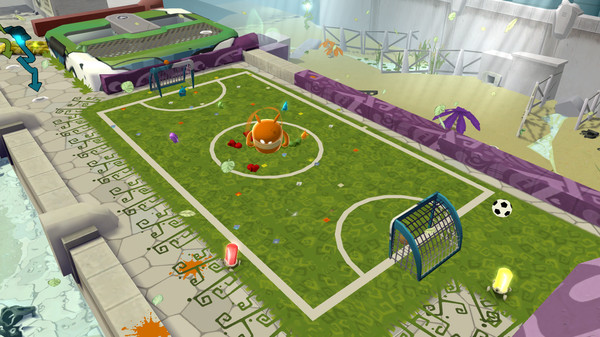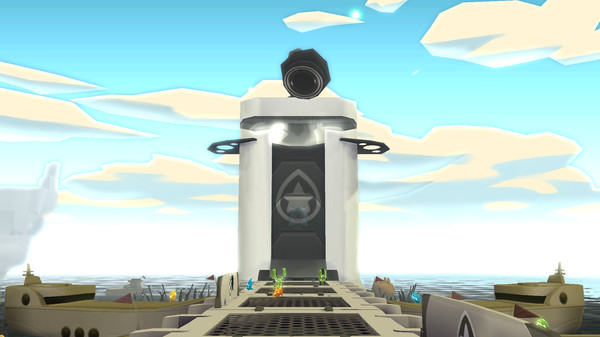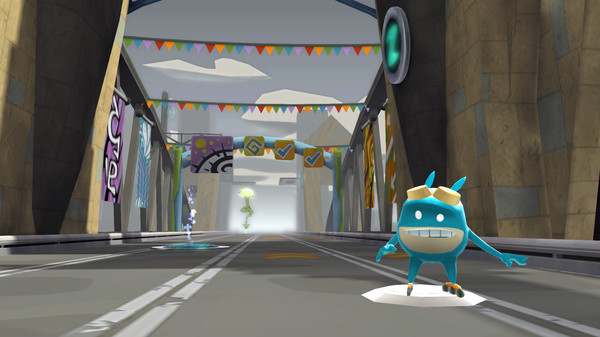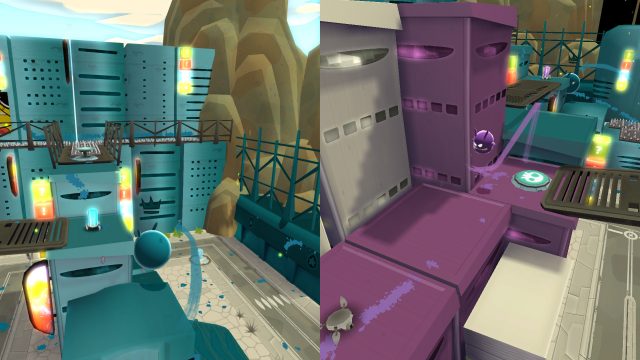
The Wii may have been a shovelware magnet, but that’s not to say that it didn’t have some great games. Though they were few and far between, and were greatly outnumbered by rushed, shallow and terribly made cash-ins, they did exist. Of course, there were the popular, triple-A standouts like Super Mario Galaxy 1 & 2, The Legend of Zelda: Twilight Princess, Kirby’s Epic Yarn and New Super Mario Bros. Wii, but said titles weren’t alone. Some simply didn’t get the recognition they deserved, including No More Heroes and its sequel.
Overshadowed and almost forgotten was THQ’s de Blob, which recently made its way to the Xbox One and PlayStation 4 with some control alterations and visual upgrades in tow. Nine-and-a-half years may have passed since the game first released, but it’s back and looking to make new friends during a crowded holiday season where most of the talk is about loot boxes and pay-to-win schemes as opposed to games themselves. You’d think they would’ve waited to release it during a quieter time, but they didn’t.
Truth be told, this isn’t the first time that de Blob has been re-released, as it actually made its way to Steam a little while back. Now it’s available for consoles twice removed from the one on which it originated. And, though it’s not a great game, or one of the Wii’s absolute best, its simple mechanics and relaxing gameplay still hold up well today.
Best described as being quirky, colourful and unique, de Blob is a game about bringing colour back to an alternate version of earth. One that has been stripped of its rainbow of hues by the dastardly INKT Corporation, its leader Comrade Black and his army of inkies.

Having lost their colour, this world’s once vibrant cities, plants and landscapes have all been reduced to black and white versions of themselves. Thus, their sparkle and beauty have been stolen, and in their place is a boring and far from lively place. Hell, they even got to the people, who’ve turned greyscale as a result.
This eight, or so, hour-long campaign begins after the deed has been done. As the inkies finish up and start to congratulate themselves for a job well done, they come face to face with resistance in the form of a sizeable blob with no real name. With no back story to tell, he’s come to save the day and won’t stop until everything around him has had its colour restored.
This plot line likely sounds like it’s out of a Saturday morning cartoon, or some sort of kid’s game, and perhaps it’d fit right in there. de Blob isn’t just for kids, though, and is the type of experience that appeals to all ages. It’s involved enough to entertain the hardcore, but lacks the type of challenge that lots of other games possess, making it easy to get into for those who don’t game all that often, if at all. There’s limited challenge, outside of the odd spurt, and the annoying final boss.
From start to finish, the player has one goal, with that being to return colour to the world. This is done by visiting different regions (over the course of ten unique stages), and using paint to bring life back to everything around you. de Blob can jump, slam himself downward, and must use these abilities to cover himself in paint that is then transferred to things like buildings, trees and billboards. How this works is very simple: You move around the environment, by rolling and/or jumping, and collect paint from little robot like creatures that litter the game world. By running into, or slamming down upon them, you’ll assume their colour and become slightly bigger thanks to the added paint. There are a couple of catches, though, because colours can be blended to create others (like blue and red for purple, or yellow and blue for green), and the amount of paint the creature carries correlates to the amount of health he has at any given time.

Levels are preceded by short and humorous cutscenes, which conclude prior to de Blob entering each newfound environment. It’s then that he gets an introduction of the area from one of the other members of the resistance, who speak in Simlish that is then translated into English inside of speech bubbles. These characters occasionally offer tips and present the lay of the land during the course of each mission, but other than that there’s very little in the way of story or dialogue. You’re mostly left to your devices, and can do whatever you want, though it’s not as simple as just painting things at whim.
Every twenty to thirty minute stage is broken up into a few different areas, with each one being open for traversal and exploration. The idea is that, through progression, you’ll get to different point plateaus, which will then allow you to unlock a gate leading to the next section. The meter is for show, though, because everything is points related. This means that if you opt to stay in one area and focus on it, you’re likely to eventually earn enough points to unlock the next couple of gates. This will allow you to bypass parts of levels if you please.
These sections are full of buildings, homes, billboards, trees and more, and are also littered with lots of colourful (and squiggly) arrows. Said indicators act as the starting points for challenges, which show their individual difficulties through a three star system. Challenges are the best way to earn points, but most of them relate to painting in some way or form, and the truth is that there’s not a lot of variety among them. Some will ask the player to paint certain buildings specific colours (something that gets more intricate and involved as the campaign moves towards its conclusion), while others will task them with racing from one spot to another. Others involve combat, which begins by introducing basic enemies who can be flattened with ease, but eventually evolves into battles against tans and turrets that shoot ink. There are also upgraded foes, some carrying ink sprayers and others wearing armor that can only be broken by a specific colour.
Ink is your number one enemy here, and for good reason. On top of sapping the colour from this alternate earth, it’s also toxic to whatever our rotund protagonist happens to be. Getting hit with ink, then, depletes your paint quotient until it drops to zero and death occurs. Lives are plentiful, though, and water fountains are numerous, usually allowing for a quick rinse off. There will be times, though, where you’ll find that they’re too few and far between, or will curse the (occasionally problematic) camera for causing you to jump somewhere you didn’t mean to, resulting in death.

The aforementioned challenges start off fun, but tend to get stale after a while, due to their inherent lack of variety. In the latter stages of its campaign, de Blob becomes race heavy, and also starts to rely too heavily on challenges that force you to collect a certain amount of paint (the character can hold 100 drops at any time), then jump into a hole in a building of some sort. Thus ensues a boring mechanic, where you repeatedly press the A button to deposit the amount of paint that is required to free said building of its greyscale curse. Needless to say, it’s hard on one’s controller, especially since one press is equivalent to depositing one drop. With most buildings requiring 30 to 50, and sometimes even 100 drops of paint, you can imagine how many times one must press the poor button in order to progress.
There are time limits, too, as every challenge has one. So, too, does each level, although this constraint will only affect those who go for 100%. Clock-shaped pickups are so prevalent that it’s easy to increase the time limit into double digits, to the point where you’ll likely never have to worry about it. That is, unless you’re one of those completionist folks, the likes of whom will be spending upwards of twenty to thirty hours painting everything that this game has to offer. If you’re not interested in that type of commitment, worry not, because it’s possible to beat the game while only painting 25-30% of each level. You’ll miss out on achievements and trophies, but this is a list that will likely frustrate more than it will entertain. Reason being is that you only get minimal rewards for completing each stage (and the game as a whole), since most of the point and trophy rewards are tied to painting absolutely everything, which will take a long time to do because the stages are huge.
There’s only the one boss battle to be found, but this isn’t the type of experience that needed more. It’s supposed to be unique and relaxing, and isn’t designed to be difficult or stressful. Sure, those things come into play on occasion, but it isn’t until closer to the end of the campaign that things become even remotely challenging. Part of this slight challenge also comes from the controls, which aren’t always as tight as they could’ve been. Simply put, de Blob is a bit floaty, and his movements aren’t as precise as those in bigger budget platformers.
The main problem with this game, though, is how repetitive it is. Yes, it’s nice looking and vibrant, but the gameplay is too similar throughout. Since there’s little in the way of variety, you’re doing the same things ad nauseam over the course of at least seven or eight hours. This will, of course, bother some more than others, but it got to me after a while and made me hope that the credits would roll sooner rather than later. It’s not that I didn’t like the game, it was just too repetitive to love. Playing it in longer sessions also wasn’t a great idea, because it’s best suited for shorter ones. And the music gets to be annoying after a while.

Being that this is a port, it’s also important to talk about how it looks and runs in comparison to today’s games. Well, the truth is that the performance — at least on an Xbox One X — is nearly flawless, and the action looks quite good in the process. Adding colour to the world makes for some great juxtaposition, and the colours, themselves, are super vibrant. The only real issue with this upgraded version is that it feels like some of the cutscenes were forgotten about. The opening and closing ones, especially, because they’re muted and blurry which isn’t the case with the rest of the game. It’s like they weren’t even touched.
That said, since I’ve never played the original version I can’t say for sure. This is a game that had been on my to-play list for years, so I’m glad that I finally got to it. When it first released, I asked for it for a holiday gift from a close family member who’s no longer with us, but didn’t get to it because I was renting too many games and didn’t love the Wiimote. Finally playing through it has allowed me to rectify that regret.
Well, sort of.
At the end of the day, de Blob is a game that is still worth picking up and playing through even though more than nine years have passed since it was first released. Although this remaster could’ve used some more work (on its cutscenes), the core gameplay looks, plays and performs well, and offers a nice change of pace from today’s more action packed and demanding titles. That said, this still isn’t an experience that everyone will enjoy or appreciate, because of how slow paced, methodical, repetitive and serene it is. And, while it supports multiple players, it may be difficult to find friends who’ll want to come over and play this over something more exciting.
**This review is based on the Xbox One version of the game, which we were provided with.**

